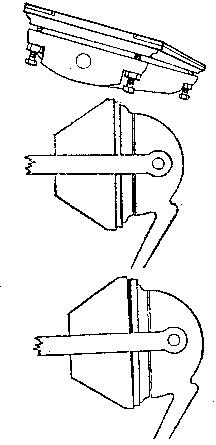By Fred Williams
Editor and Publisher—Type & Press
Winter 1985
 In printing various size type forms, the novice pressman may encounter difficulties in obtaining consistently good results. If ink rollers, wheels and tracks are in good condition and proper makeready procedures have been followed, the problem may be traced to the fact that the platen is not level.
In printing various size type forms, the novice pressman may encounter difficulties in obtaining consistently good results. If ink rollers, wheels and tracks are in good condition and proper makeready procedures have been followed, the problem may be traced to the fact that the platen is not level.
The need for leveling may become apparent after several consecutive runs of heavy or weak impressions appear at the same relative position on the platen.
The platen should be exactly parallel with the type and bed of the press as impression is made. If it is not, realignment may be accomplished by adjusting the screws located under the platen surface casting. Most presses are equipped with four or five of these “adjusters.” A few larger machines have more.
For a small type form of only one or two lines of 10 point type, three or four sheets under the top sheet may be sufficient. But when a large, full form with display lines or halftones is put on the press, more impression is required. Consequently, additional packing must be placed under the top sheet to compensate for the extra spring in the press. On the Gordon and clam shell presses, in which the platen and bed swing back and forth in the “hinging” action, this added packing will result in a heavier impression at the bottom of the form.
In the “clam shell” style of press (Baltimore, Clipper, Excelsior, Pearl, Favorite, Star, Kelsey, Jewell, Lightening, Peerless, C.M.C., Model, Official, Prouty, etc.) it is necessary to raise the screws on the upper edge of the platen when any considerable increase is made in the amount of tympan packing.
In Gordon type of press (C&P, Ben Franklin, Challenge, Cleveland, Old Reliable, Franklin Jobber, S&L and others) this difficulty is not as much of a problem. By carrying the hinging point nearly to the floor, the variation is slight. Yet it is there & must be compensated for in the makeready.
To check the levelness of the platen and properly adjust it, if needed, is a simple procedure and will require only a few minutes.
First, place five 48 or 60 point cap M characters, one in each corner of the chase and one in the center. If you don’t have any large type, set four of the largest size available in the cluster in each corner. Or foundry or Monotype border pieces can be placed long enough to extend around the circumference of the top sheet. Do not use strip or slug cast borders. Whatever material is used, make sure it is type high. Plane form, lock it up and place on the press.
With a small amount of ink on the plate take an impression. Examine the proof. If one of the letters is weaker or heavier than the others, that side will have to be adjusted.
To expose impression screws, close press by hand until platen is against type. Between the bottom of the platen and the rocker are two sets of double screws. On most presses the nut nearest the platen is the one that moves the paten toward or away from the type plane. The lower screw of each set is the jam or the lock nut, used to hold the top one in place after it has been set.
If one corner is too light, loosen the lock nut on that corner and turn the top one with a wrench in the same way as the lock nut was turned. That will increase the impression on that corner. If less impression is needed, turn adjusting nut opposite direction than the lock nut was turned.
Now make an impression on a sheet of book paper and examine the back side of the sheet for excessive impression. If O.K., secure lock nut, being careful that impression screws are not altered in the process.
The two lower sets of screws seldom need adjusting. If needed, they may be re-set form the back. Rollers should be on their up ward stroke so as not to interfere when adjustment is made on these screws.
On the sliding platen type of press (Colt’s Armory, Universal, Hartford, Victoria, etc.) it is not necessary to adjust the impression screws when going from light to heavy forms. On these presses, the bed is vertical and fixed. The platen, instead of being hinged, rolls up from feeding position until it becomes vertical with the form. From this position it is pulled directly parallel against the type form.
